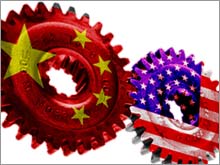|
Four U.S. firms that fought off China These family-owned companies have stayed alive even as competitors closed doors, sending millions of jobs offshore. NEW YORK (CNNMoney.com) -- Six years after John Baker first heard the term "China price," his plastic injection molding business has lost two-thirds of its work force, 60 percent of its revenue and more than half of its big American corporate clientele. But unlike the 40,000 small to midsize American manufacturers that have vanished since the late 1990s, Baker's 60-year-old family-run Diamond Tool and Die company based in Dayton, Ohio, is still around.
Surprisingly, he's even seeing a moderate swing-back in business that was lost to China and other low-cost manufacturing hubs. Likewise, Herb Tucker's metal stamping business, Tucker Industries, based just outside of Bensalem, Pa., is "holding its own" while many of its competitors are going out of business. In a David versus Goliath battle, Baker and Tucker are just two examples of a handful of niche American manufacturers that have found a way to stay alive despite paying the heavy cost of the China price. A heavy price to pay China's entry into the World Trade Organization (WTO) in 1999 spurred a rapid exodus of manufacturing from the United States into China - and the loss of about 2.6 million jobs, according to government figures. The U.S. Business and Industry Council (USBIC), a trade group that represents 1,500 small and midsize manufacturers, estimates there are nearly 300,000 manufacturing companies in the United States. These family-owned companies typically have the greatest exposure to the China price, explained Alan Tonelson, a research fellow with USBIC. Smaller manufacturers often make small parts and components to supply to bigger U.S. manufacturers. "Obviously the big manufacturers want the best price possible. About six years ago, the big players told smaller vendors that unless they substantially drop their prices, they would source from Chinese companies making the same products for a lot less," Tonelson said, a bargaining tactic known as the China price. "Many U.S. producers couldn't match the prices - as much a 40 percent lower - and they shut down," he said. "It's not surprising that we're experiencing a vanishing industry syndrome in the United States. There's only one color TV maker left in America and that, too, is foreign-owned now." Ironically, some parts of domestic manufacturers are thriving even as the nation's trade deficit with China is on track to top last year's $202 billion, a record high. "Our members are squeezed from both sides," Tonelson said, noting they have to focus on quality but also need to keep reinvesting in their businesses. "But the China Price isn't allowing them to get the profit margins they need." Surviving against the odds Diamond Tool's Baker, whose customers include some of the top Fortune 500 companies, said he gets new business through a competitive bid process. "We quote our prices and how long it will take us to fulfil orders," Baker said. "In the mid-90s we were steadily losing business to China," he added, noting he estimates as much as half of his industry has moved overseas. So how is he surviving? "We downsized, changed our business focus and model," he said. Previously, $80 out of every $100 in orders was to design and build molds, Baker said. "But now we're heavily into repairs and revisions of molds," he added, noting that manufacturers need repairs made quickly, so the business is less susceptible to competition from overseas. Meanwhile, he's also benefiting from China's labor crunch and power shortages that have plagued some of its manufacturing capacity. "Some of our clients who bought tools in China have discovered problems with them. So we're seeing a little bit of a pickup in business," he said. For his part, Herb Tucker said his metal-stamping business has been "pretty steady" for a while now. The company, which traditionally supplied parts to appliance makers, decided to diversify. "We have to go to what's left in the country. We now supply to rifle makers and to truck and motorcycle manufacturers," Tucker commented. He wouldn't disclose sales numbers but mentioned sales "were increasing." Atlas Tool and Die Works, a Lyons, Ill.-based family-owned business since 1918, employs 70 people that use lasers and other equipment to shape metal for customers and make housing panels, doors and industrial products. Some of its biggest customers are telecom firms. Zachary Mottl, the company's director of strategic development, said competition from China forced Atlas to slash prices 30 percent even as management grappled with high energy and health care costs. "Initially we were down 50 people but we've hired again," Mottl said. To offset the competitive threat from overseas, the company also shifted its focus to other industries that didn't pose the risk of going to China anytime soon. "Defense is a good area for us," Mottl remarked. "The defense industry needs speedy delivery and high-quality from its vendors." Similarly, John Bello, who owns a textile printing business in Paterson, N.J., has found new niche markets. His company - Textile Trans-print Corp. - makes fabric for bedspreads, window treatments and garments. His customers supply some of the biggest retailers including Wal-Mart (Charts), Fortunoff and Bed, Bath and Beyond (Charts). "We supplied fabric to manufacturers who sold to these retailers," Bello said, adding many firms moved lock, stock and barrel to China to stay cost-competitive. Bello got creative. "We got into industrial fabrics for hospitals and hotels. These fabrics are guided by strict federal guidelines and we saw an opportunity for us in this space." "For us and others, you have to reinvent your business almost every day to stay alive," Bello said. China labor pains and holiday woes |
|

